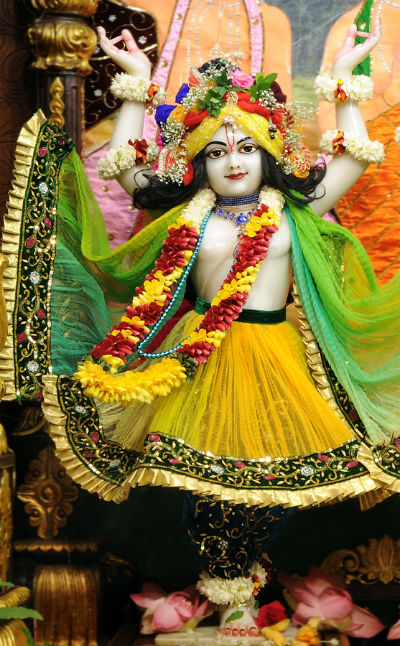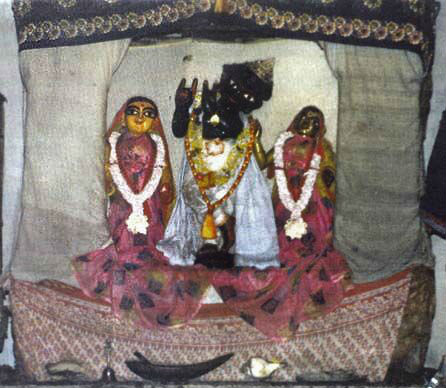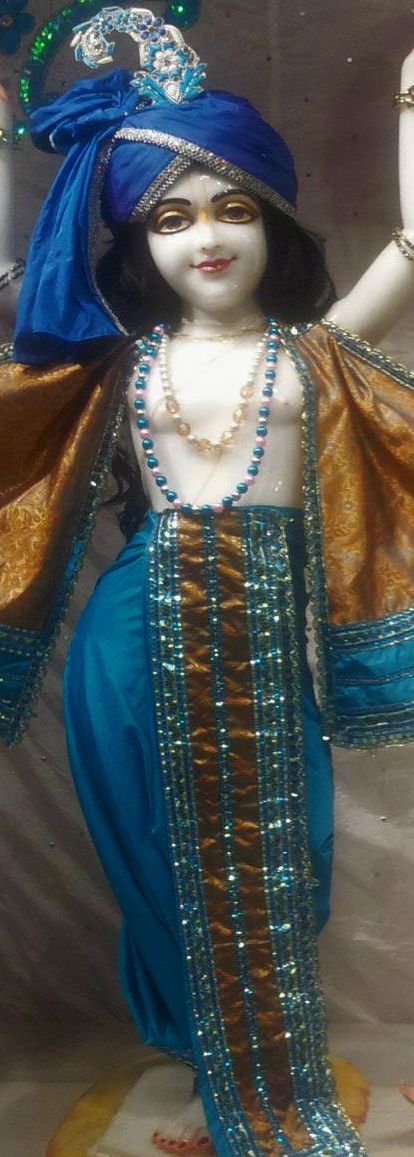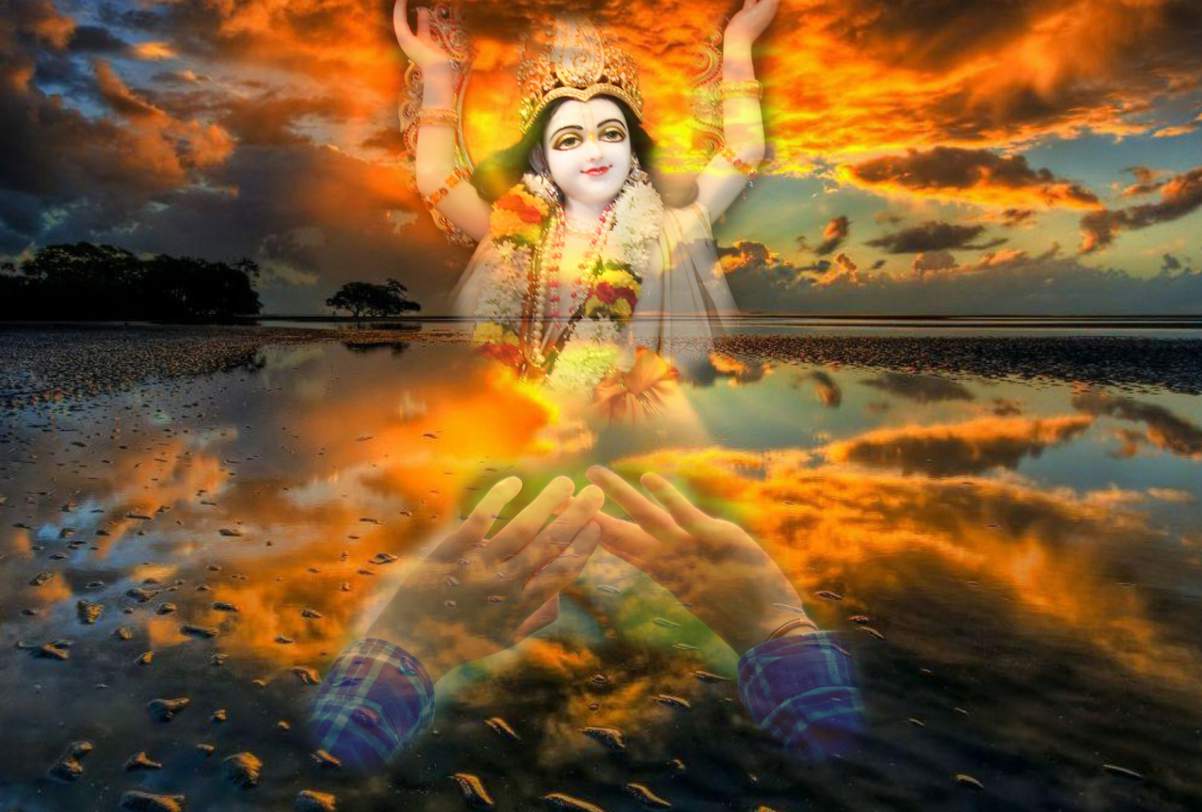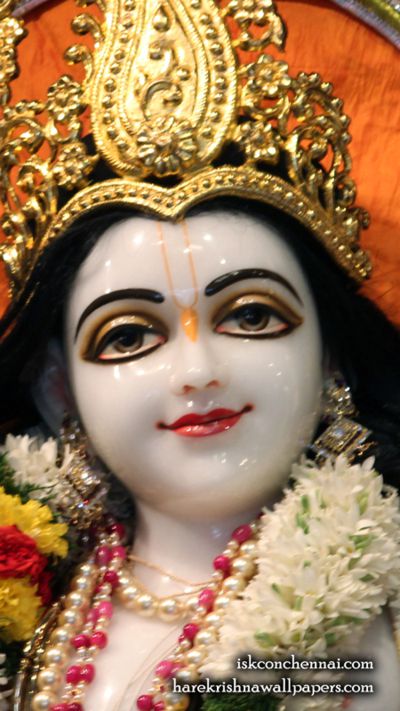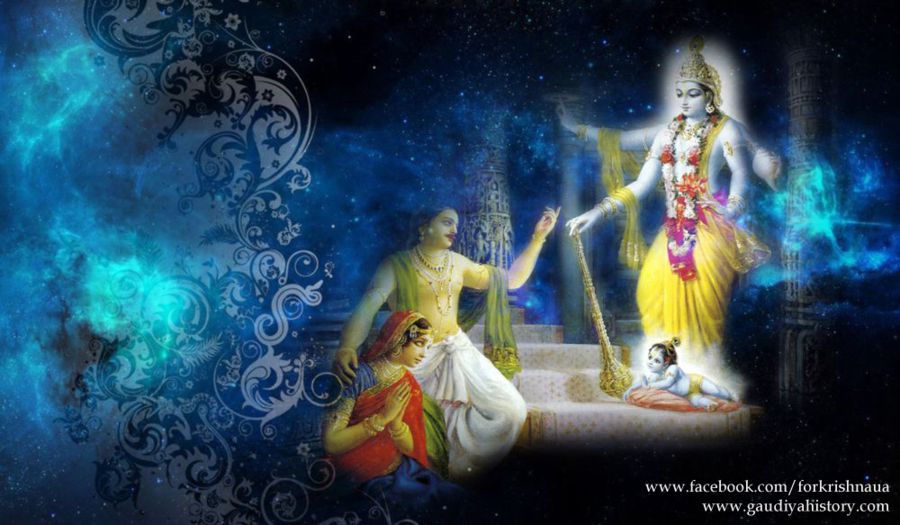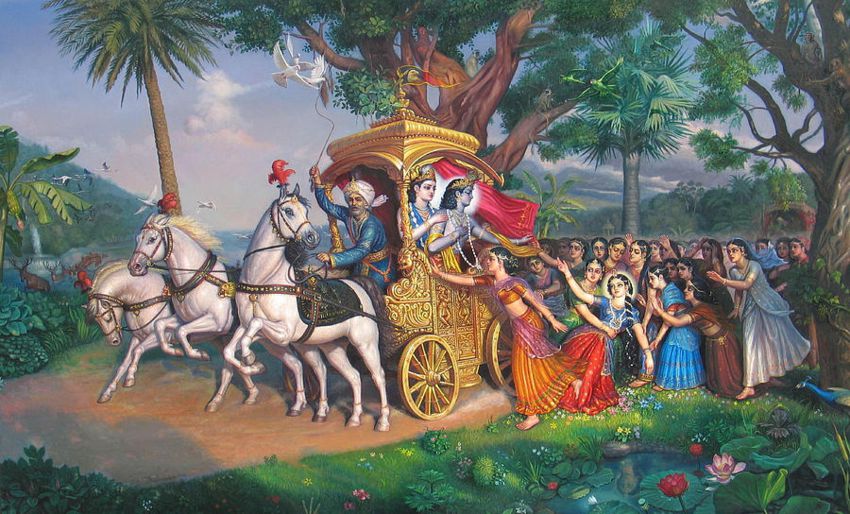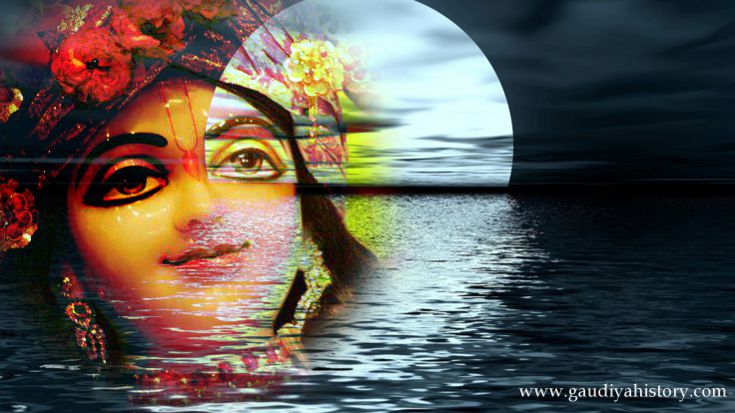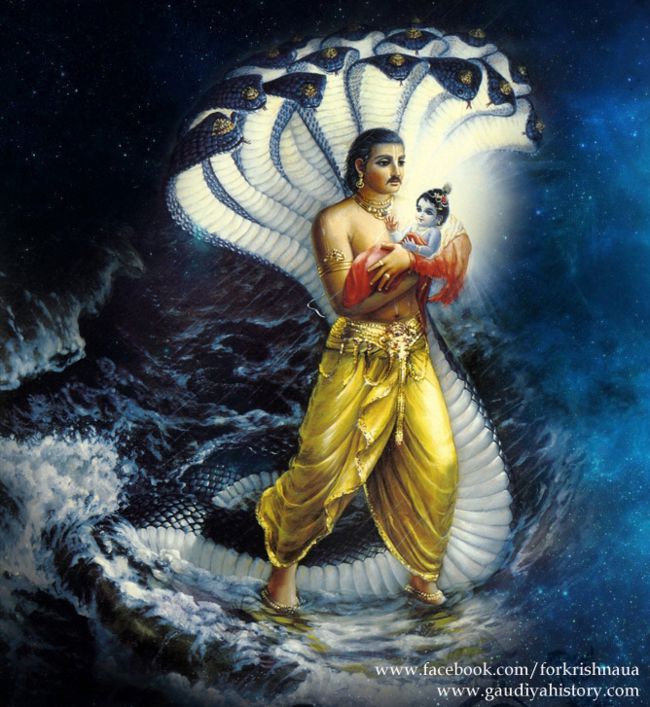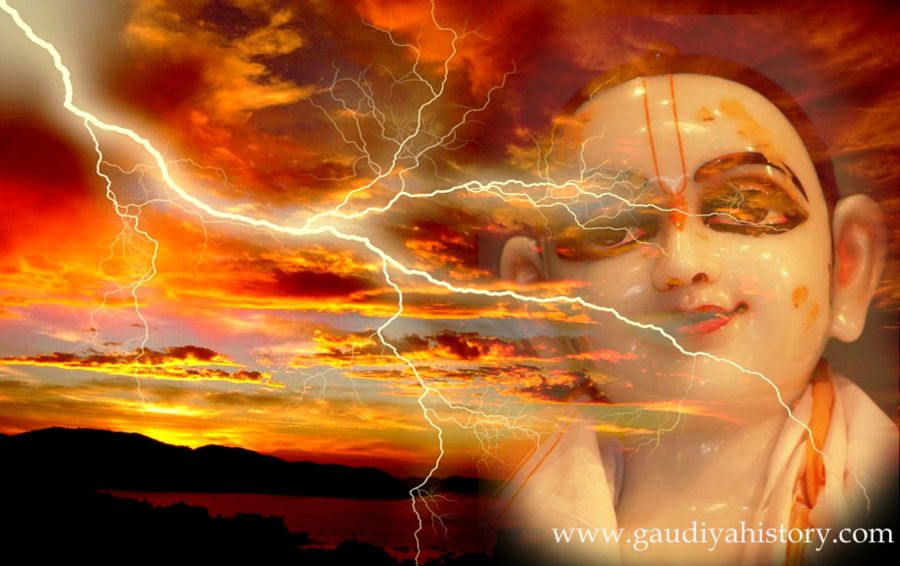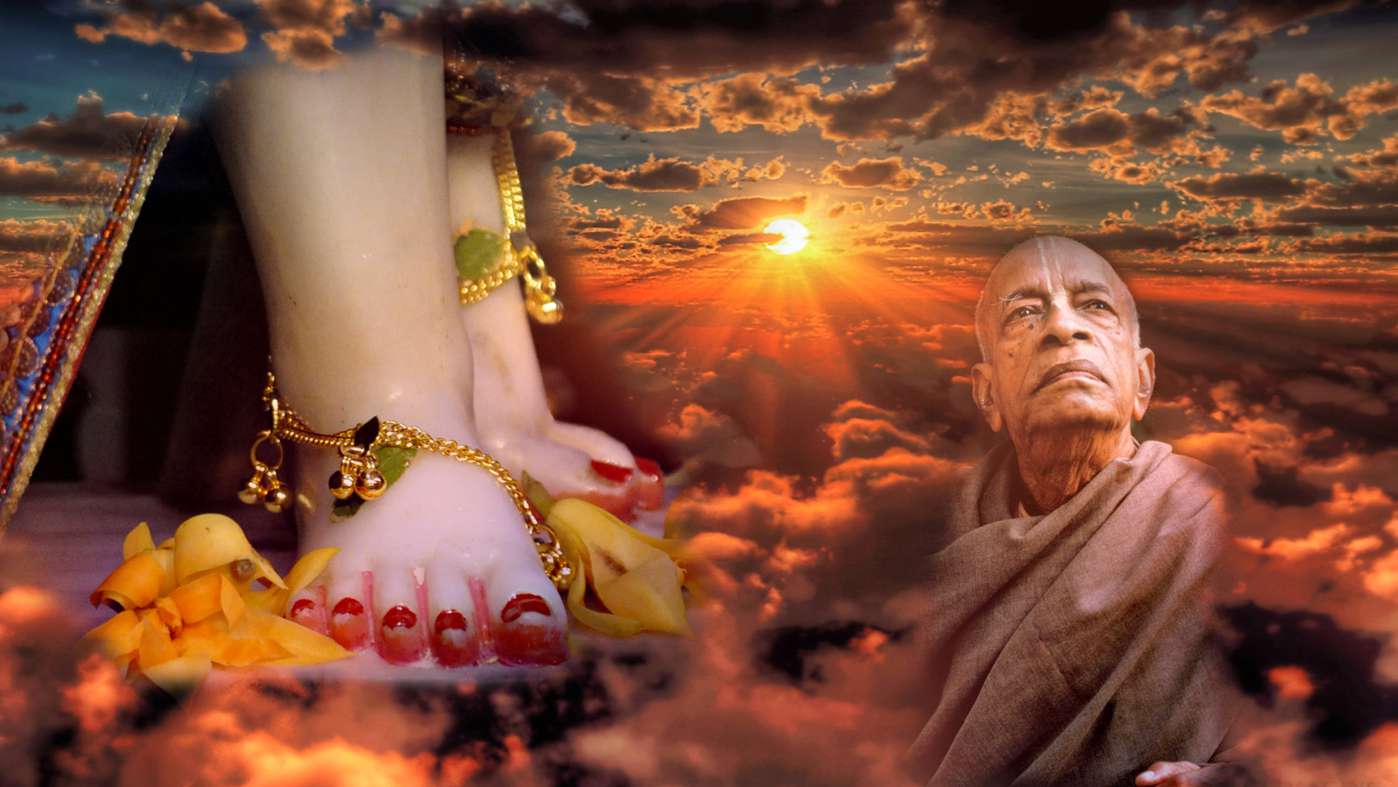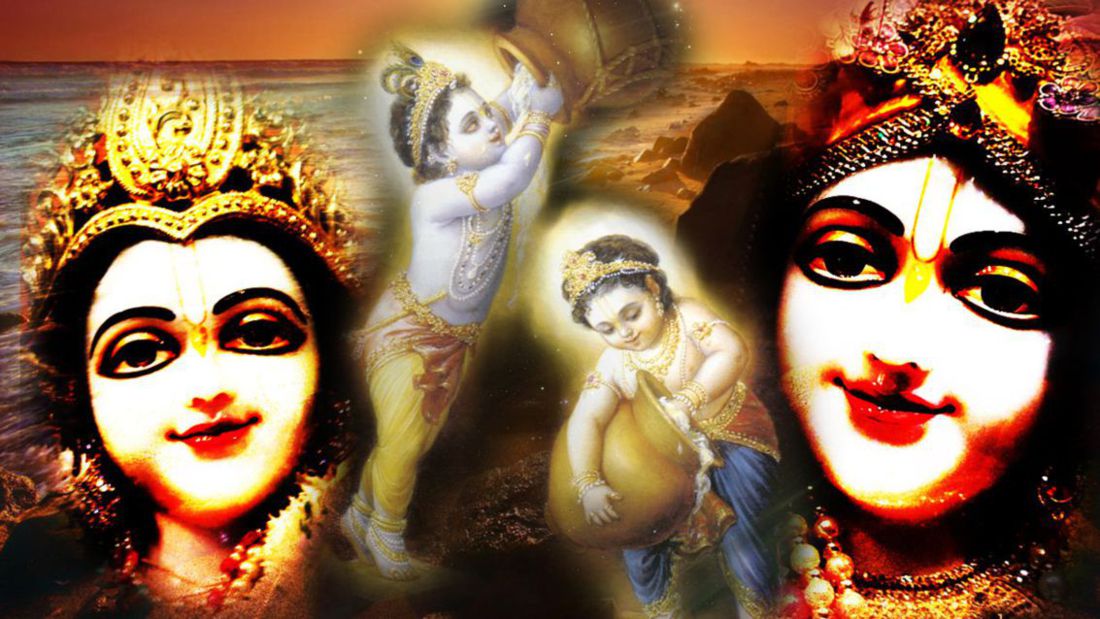
Who was formerly the son of Nanda Maharaja, He has appeared as the son of Sachi Devi.” Chaitanya Mahaprabhu’s mother’s name was Sachi Devi. So Krishna. Krishna is Shri Chaitanya Mahaprabhu, and Balarama is Nityananda Prabhu. (In the wallpaper: Shri Shri Gaura Nitay in right and left sides, ISKCON Chennai, Shri Shri Krishna Balarama in the middle).
Prabhupada: So today, the appearance day of Nityananda Prabhu… Nityananda Prabhu is Baladeva, Baladeva-tattva.
vrajendra-nandana yei, saci-suta haila sei,
balarama haila nitai
“Who was formerly the son of Nanda Maharaja, He has appeared as the son of Sachi Devi.” Chaitanya Mahaprabhu’s mother’s name was Sachi Devi. So Krishna. Krishna is Shri Chaitanya Mahaprabhu, and Balarama is Nityananda Prabhu. Now.
vrajendra-nandana yei, saci-suta haila sei,
balarama haila nitai
So Balarama… In the Vedic literature it is said, nayam atma bala-hinena labhyah; na bahuna srutena. So bala means strength. Sometimes some rascal philosophers, they take it that bala means bodily strength. They propagate this philosophy that “Unless you are bodily stout and strong, you cannot achieve spiritual salvation. You must be very strong and stout and eat meat and fight, and then you’ll get next spiritual birth” No. This bala, this strength, is different. This is spiritual strength.
The difficulty of the present situation is that actually we are moving on account of spiritual strength, but they have no information of the spiritual strength. They are thinking of material strength. That is expressed here, that
ahankare matta hoiya, nitai-pada pasariya,
asatyere satya kori mani
This is due to ahankara. Ahankara-vimudhatma kartaham iti manyate. Those who are vimudha, especially rascal… Mudha, rascals, and vi means visesha, viseshanam, particularly. Ahankara- vimudhatma. The same thing which is spoken in the Bhagavad- gita, Narottama dasa Thakura says the same thing in a plain Bengali language. Ahankare matta haiya, nitai-pada. By the spell of maya ahankara-vimudhatma kartaham iti manyate they are thinking that “We are independent. We can do whatever we like.” This is called ahankara-vimudhatma. Under false pretext, false prestige, everyone is thinking that “We are independent. We can find out the solution of the problems of life by material adjustment,” so on, so on. So that is our material disease. Ahankara-vimudhatma. Bewildered, they do not understand that the real strength is spiritual strength. We see daily, see daily that a very strong man, very powerful man, very good brain, very good scientist… So where is the strength? The strength is atma. As soon as the atma, or the soul, goes out of this body, so intelligent, so strong, and so many things, that is nothing. That is the difference between dead man and the living man. A living man is very powerful, very good position, everything. As soon as he lies down, he is lying down on the floor, and if you kick him on his face, he’ll not protest. So where is that strength? The strength is gone. That is spiritual strength. On the spiritual strength, the body moves. Suppose you have got a very good car, Mercedes car or Rolls Royce car. But when there is no petrol, how the car will move? It is not possible. There is spirit, petrol spirit. Similarly, real strength is spiritual strength. That spiritual strength is Balarama. Bala means strength. Therefore we have to take shelter of the lotus feet of Balarama, guru-tattva.

So where is the strength? The strength is atma. As soon as the atma, or the soul, goes out of this body, so intelligent, so strong, and so many things, that is nothing. That is the difference between dead man and the living man. A living man is very powerful, very good position, everything. As soon as he lies down, he is lying down on the floor, and if you kick him on his face, he’ll not protest. So where is that strength? The strength is gone. That is spiritual strength. On the spiritual strength, the body moves. Suppose you have got a very good car, Mercedes car or Rolls Royce car. But when there is no petrol, how the car will move? It is not possible. There is spirit, petrol spirit. Similarly, real strength is spiritual strength. That spiritual strength is Balarama. Bala means strength. Therefore we have to take shelter of the lotus feet of Balarama, guru-tattva. (In the wallpaper: Shri Balarama).
Balarama means guru-tattva. Balarama represents guru. Yasya prasadad bhagavat-prasadah. If we want to understand Caitanya Mahaprabhu, if we want to understand Krishna, then we must take shelter of Balarama. Nayam atma bala-hinena labhyah. This bala- hinena labhyah, this Vedic injunction, means “Without the mercy of Balarama you cannot understand, you cannot realize your spiritual identification. So that Balarama comes as Nityananda Prabhu. Balarama haila nitai. Therefore we must take shelter of Balarama. That is.This song has been sung by Narottama dasa Thakura. Nitai-pada-kamala, koti-candra-susitala. If we take shelter of Nityananda Prabhu, then we get peace. Koti-candra-susitala. Just like in daytime, especially in the summer season, we become very much exasperated. But at night, in the evening, as soon as there is moonshine, we become very much satisfied. All day’s labor and fatigue is immediately moved. So nitai-pada-kamala, the shade of Nityananda Prabhu’s lotus feet, is koti-candra-susitala, as pleasing as one crore of moonshine. One moonshine gives us so much pleasure. So if we want actually peace of mind, if we actually want to be free from this material fatiguement, then we must take the shelter of Nityananda Prabhu. Nityananda Prabhu is the strength, spiritual strength. And without spiritual strength you cannot approach Krishna. Nayam atma pravaca… Simply by talking nonsense… Nayam atma pravacanena labhyah. If you are a good speaker, that does not mean you’ll understand, yourself. Na medhaya: “Neither by good brain.” Because you have got very good brain you’ll understand Krishna no. Nayam atma pravacanena labhyo na medhaya na bahuna srutena. If you think that you are a very good scholar, university degree-holder, then you’ll understand no. This is not possible.
So we must have spiritual strength. That source of spiritual strength is Balarama, Krishna’s next manifestation, prakasa-vigraha. Krishna is manifesting Himself through Balarama. So we have to take shelter of Nityananda Prabhu.
nitai-pada-kamala, koti-candra-susitala,
je chayay jagata juray
The whole world is suffering, but if you want peace, then you take the shelter of Nityananda Prabhu.
heno nitai bine bhai, radha-krishna paite nai
dhridha kori’ dharo nitair pay
Our real aim of life how to go back home back to Godhead and associate with Radha Krishna. In another song the same author says,
manushya-janama paiya, radha-krishna na bhajiya,
janiya suniya bisha khainu
Unless you come to Radha-Krishna, you cannot get real pleasure. If you want to dance and get pleasure, don’t dance independently. Dance with Krishna. Then you’ll be happy. The dancing is there, but dancing without association of Krishna. Just like here, in our Temple, we are also eating, but we are eating the remnants of foodstuff left by Krishna. That is real pleasure. It is not that we are stopping eating. We are not stopping eating. We are not dry philosophers. Krishna baro doyamoy, koribare jihwa jay, swa-prasad-anna dilo bhai. All over the world we are eating Krishna Prasadam, and we have got good experience. At least ten thousand men and women, they are taking Krishna Prasadam, but we have no anxiety. We have no anxiety. A family consists of a few members. They are full of anxiety how to maintain the family. And we are maintaining a family of ten thousand men. We have no anxiety. Just see practically. We have no anxiety. We require thousands and thousands of rupees for maintaining Europe, America, a costly affair. But because we are under the shelter of Nityananda Prabhu, Balarama, we have no anxiety. That means material life means anxiety. You cannot avoid anxiety if you lead a material life. Then you will be anxious.
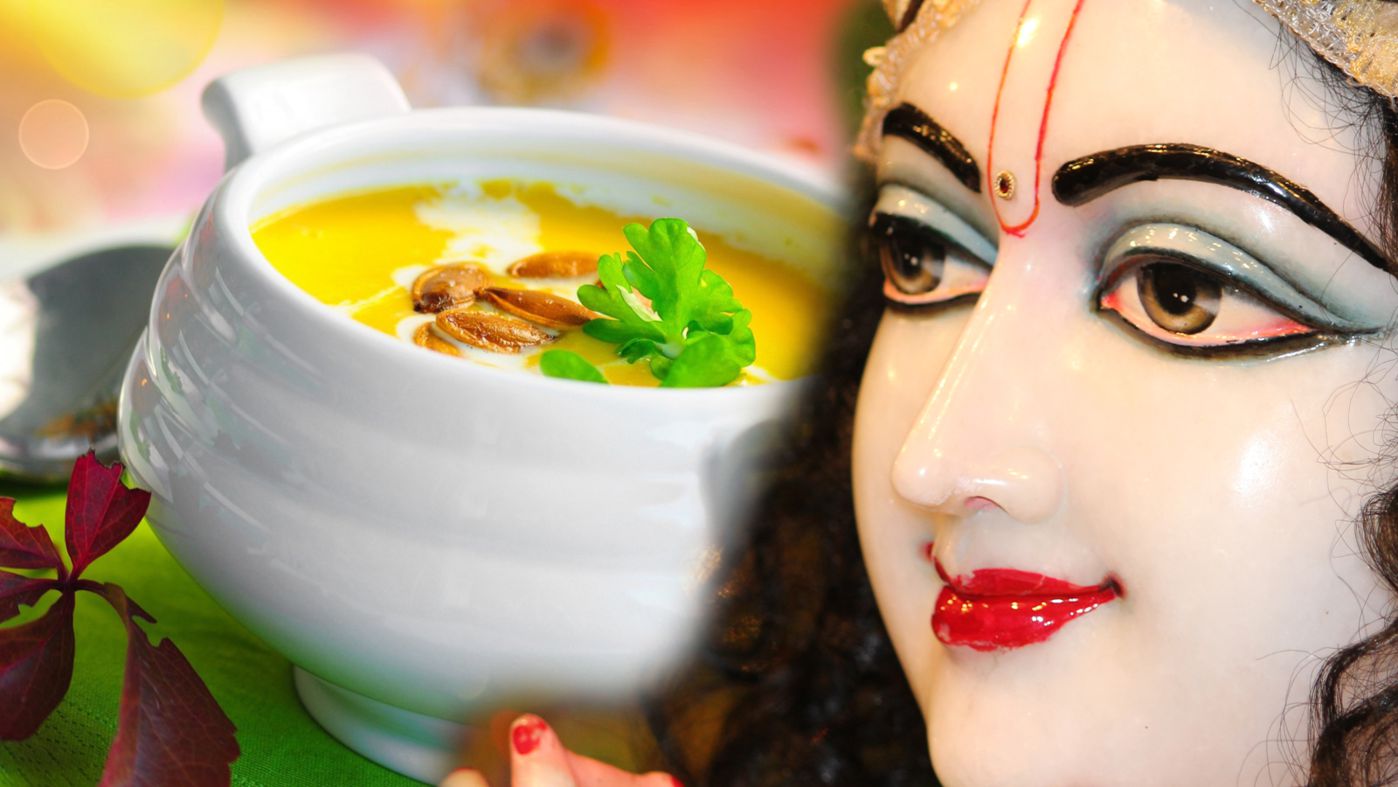
Just like here, in our Temple, we are also eating, but we are eating the remnants of foodstuff left by Krishna. That is real pleasure. It is not that we are stopping eating. We are not stopping eating. We are not dry philosophers. Krishna baro doyamoy, koribare jihwa jay, swa-prasad-anna dilo bhai. All over the world we are eating Krishna Prasadam, and we have got good experience. At least ten thousand men and women, they are taking Krishna Prasadam, but we have no anxiety. We have no anxiety. A family consists of a few members. They are full of anxiety how to maintain the family. And we are maintaining a family of ten thousand men. We have no anxiety. (In the wallpaper: Shri Krishna, ISKCON Chennai).
That is Prahlada Maharaja’s instruction. He was asked by his father, “My dear son, what you have learned, the best thing from your teachers?” So he replied, “My dear father” He never said, “My dear father”; He said, “My dear best of the asuras.” Asura- varya. Tat sadhu manye ’sura-varya dehinam. Tat sadhu manye ’sura-varya dehinam sada samudvigna-dhiyam asad-grahat. The whole human society is suffering, at least suffering from one disease anxiety. Ask anybody. Take one small ant and take the big elephant; take the President of United States or take one street beggar. Ask him, “Whether you are free from anxiety?” Nobody will say, “No.” “I am full of anxiety.” That’s a fact. So why they are anxiety, in, full of anxiety? That Prahlada Maharaja had replied, sada samudvigna-dhiyam asad-grahat. Because we have taken asad-vastu, that will not exist…
Everything, whatever you have got our, this body will not exist. And this is the main platform of our existence. In the material world, so long the body is there, you exist. So Prahlada Maharaja said that “Real solution of problems of life is to get out of this material condition. That is best thing in my opinion.” Sada samadvigna-dhiyam asad. That is Vedic injunction also. Asato ma sad gamaya: “Don’t live in this asat, in this material condition.” Sad gamaya: “Go to real existence.” That real existence means spiritual life. Na hanyate hanyamane sarire. So if we actually want life, blissful life, then we must get out of this material existence. That is Prahlada Maharaja’s instruction. Samudvigna-dhiyam. And if you remain in the material existence, you must suffer some anxiety. There is no excuse.
So Prahlada Maharaja advises that hitvatma-ghatam griham andha-kupam vanam gato yad dharim asrayeta. If you… Real problem is anxiety. And this anxiety will continue so long you are material existent. Therefore the real life is to get out of this material… Hitvatma-ghatam. Atma-ghatam. Atma-ghatam means killing the soul. This material civilization is killing the soul. That They have no information of the soul. They do not know how to become peaceful, how to become blissful. They are trying to be peaceful, bahir-artha-maninah, by external material energy. They are thinking by constructing big, big buildings, just like in Bhubaneshwar they are doing, and having good, very big, big roads and motorcars, that is advancement of civilization. No. That is not advancement of civilization. That is increasing their anxiety. There is no solution of the anxiety. There is… Formerly that… I was speaking. There was no university. The university was in the cottage Vyasadeva. Vyasadeva was writing Shrimad-Bhagavatam and all the Puranas in a cottage. The university was there. Who can produce such literature as Vyasadeva has given? From any angle of vision, from literary point of view, from philosophical point of view everything, so perfect, every literature, Mahabharata, Puranas, and Vedanta. Veda-vyasa, he has given. So there was no need of university. It required clear brain. That was to be done by the brahminical qualifications, samo damo titiksha arjava, jnanam-vijnanam astikyam brahma-karma svabhava. Where is that education? This education, technical education, how you can very nicely hammer, this will not solve the problem. So if we want real solution of the problems, then our duty is first of all to take the shelter of nitai-pada-kamala. Then we’ll be happy, and we’ll get moonshine, and our all fatigueness will be subsided.
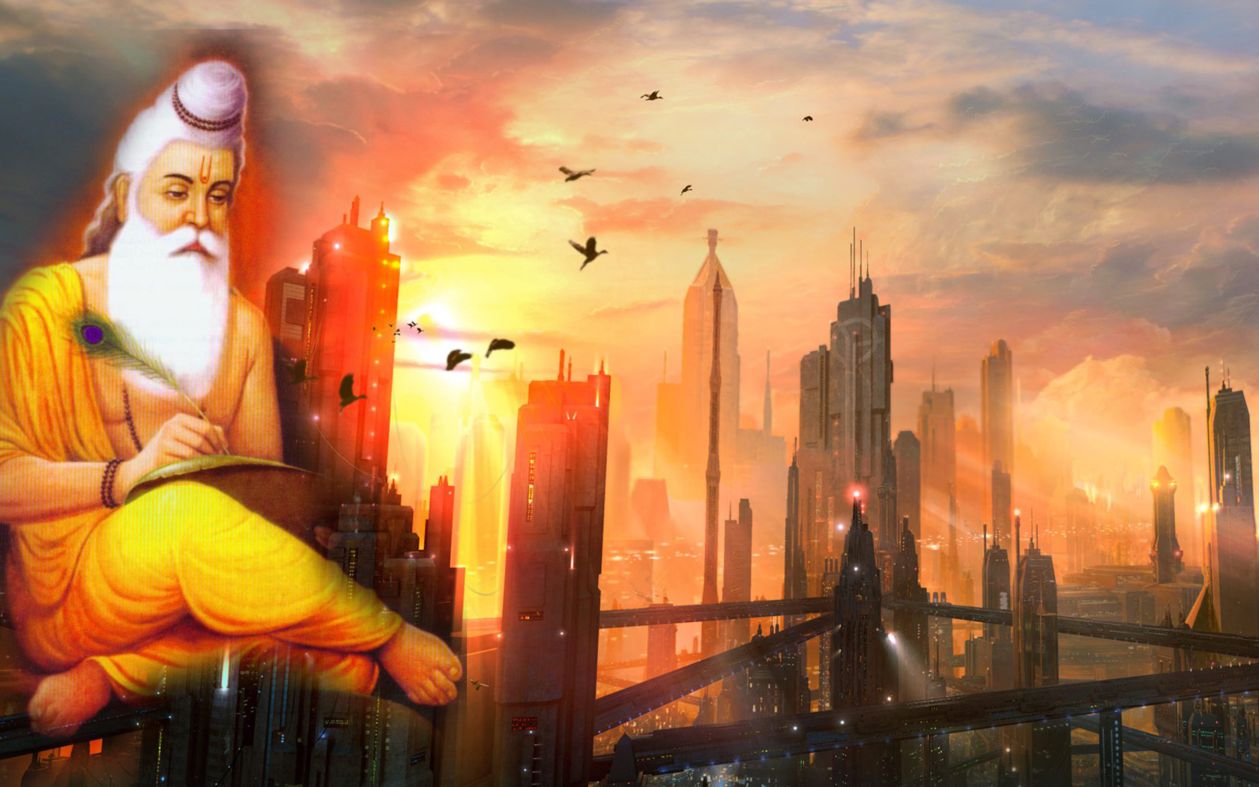
They are thinking by constructing big, big buildings, just like in Bhubaneshwar they are doing, and having good, very big, big roads and motorcars, that is advancement of civilization. No. That is not advancement of civilization. That is increasing their anxiety. There is no solution of the anxiety. There is... Formerly that... I was speaking. There was no university. The university was in the cottage Vyasadeva. Vyasadeva was writing Shrimad-Bhagavatam and all the Puranas in a cottage. The university was there. Who can produce such literature as Vyasadeva has given? From any angle of vision, from literary point of view, from philosophical point of view everything, so perfect, every literature, Mahabharata, Puranas, and Vedanta. Veda-vyasa, he has given. So there was no need of university. (In the wallpaper: Shrila Veda Vyas).
Sambandha nahi jar, britha janma gelo tar. So if you have no connection with Nityananda Prabhu. Nityananda means always. Nitya means always, ananda means pleasure. This is another meaning you can draw. So therefore, if you have no connection with Nityananda Prabhu. Se tar: “He’s simply wasting time.” Britha means useless. Uselessly, he’s wasting time. Se pasu boro duracar. And Narottama dasa Thakura has used very strong word. “Anyone who has no connection with Nityananda Prabhu, he’s a pasu.” Sei pasu. He’s a pasu, means animal. So animal, how one animal can get happiness? That is not possible. The dog, from the childhood he’s searching after food, searching after food. And cannot get food. Unless a dog has got a master, he’s street dog and he’s always unhappy. So better to become a dog of Nityananda Prabhu. Then we shall be happy. Instead of becoming dog of so many other people.. Everyone is dog. Everyone is searching after to serve a master. But none of them are satisfied because that is false master. You take real master, Nityananda Prabhu. You’ll be happy. Se pasu boro duracar. He does not know where is happiness. Where I shall become a dog? That…Our Bhaktivinoda Thakura, he has sung therefore,
vaisnava thakur, tomara kukkur,
boliya janaha more
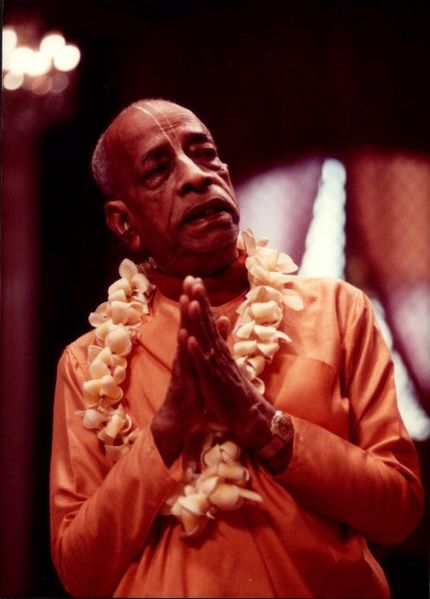
Narottama boro duhkhi. Narottama dasa Thakura, he’s acharya. He is presenting himself... That is acharya. Means he is not duhkhi, but he’s presenting himself as duhkhi. That is acharya. Acharyas, they are never duhkhi. But taking the common man’s position, he says, narottama boro duhkhi. Or, in other words, Narottama... Narottama means the best of the human being...(In the image: Shrila Prabhupada).
“My dear Vaishnava Thakura, kindly accept me as your dog, as your dog. I am dog already, but I am maya’s dog. I’m not Vaishnava’s dog. So kindly accept me.” If you become a Vaishnava’s dog. Chadiya vaishnava seva, nistar paiche keba. If you do not become a dog of Vaishnava and Nityananda Prabhu.. Nityananda is guru. So if you do not become a dog of Nityananda Prabhu, Vaishnava, or guru, there is no question of happiness. Se sambandha nahi yar, britha janma gelo se pasu boro duracar. Nitai na bolilo mukhe, majila samsara-sukhe. He who has no connection with Nityananda Prabhu, and he does not say, “Jaya Nitai! Jaya Gaura!” And majilo samsara-sukhe, he thinks that this society, family, and “Society, friendship and love, divinely bestowed upon man.” These materialist persons, they say like that. That is called majilo samsara sukhe. In samsara there cannot be any sukha, but he’s attracted by that. Majilo samsara sukhe. Vidya-kule ki koribe tar. What we’ll do with university education or born in big family or This will not help. This is not possible. Vidya-kule ki karibe tar. Why they’re accepting this false? Ahankare matta hoiya, nitai-pada pasariya, asatyere satya kori mani. On account of being misled by false prestige and false egotism, asatyere satya kori mani, we are accepting this body which is asat, which will not exist. That we have taken as reality. Ahankare matta hoiya, nitai pada pasariya. But if we take shelter of Nityananda Prabhu, then you get the enlightenment. Asatyere satya kori mani. Nitaiyer koruna habe, braje radha-krishna pabe, dharo nitai-carana du’khani.
Therefore Narottama dasa Thakura advises that Today is Nityananda Prabhu’s avirbhava appearance day. Let us at least remember today nitai-pada-kamala. That is wanted. Nitai carana satya, tahara sevaka nitya. The reality is nitai-carana, and anyone who is servant of Nitai…So nitaiyer carana satya, tahara sevaka nitya. One who has become the dog of Nityananda Prabhu, he gets his eternal life. We are eternal, but under misconception of material identification, we are under the subjugation of maya. Bhutva bhutva praliyate. Tatha dehantara. It is very botheration, but they do not know. I am going from one body to another transmigration. And that is not guaranteed, what body. They have no science, no knowledge about understanding tatha dehantara, the very first instruction of Bhagavad-gita. They are so rascals, and they are proud of their education, their universities. This is going on.
Nitai carana satya, tahara sevaka., nitai-pada sada koro asa. Therefore we should always expect to be under the shelter of nitai-pada-kamala. Narottama boro duhkhi. Narottama dasa Thakura, he’s acharya. He is presenting himself… That is acharya. Means he is not duhkhi, but he’s presenting himself as duhkhi. That is acharya. Acharyas, they are never duhkhi. But taking the common man’s position, he says, narottama boro duhkhi. Or, in other words, Narottama… Narottama means the best of the human being. So here in this material world one may be the best of the human being, very exalted position, but everyone is duhki, unhappy. Narottama boro duhki, nitai more koro sukhi: “Only Nityananda can make me happy. Otherwise not possible.” Rakho ranga-caranera pasa. So today is Nityananda Prabhu’s appearance day. We shall always pray Nityananda Prabhu, “Kindly keep me under your shelter so that. I am very duhki; I am very unhappy. Under the shelter of Your lotus feet I shall be happy.” And that is real happiness. Thank you very much.
Devotees : Jaya Shrila Prabhupada!
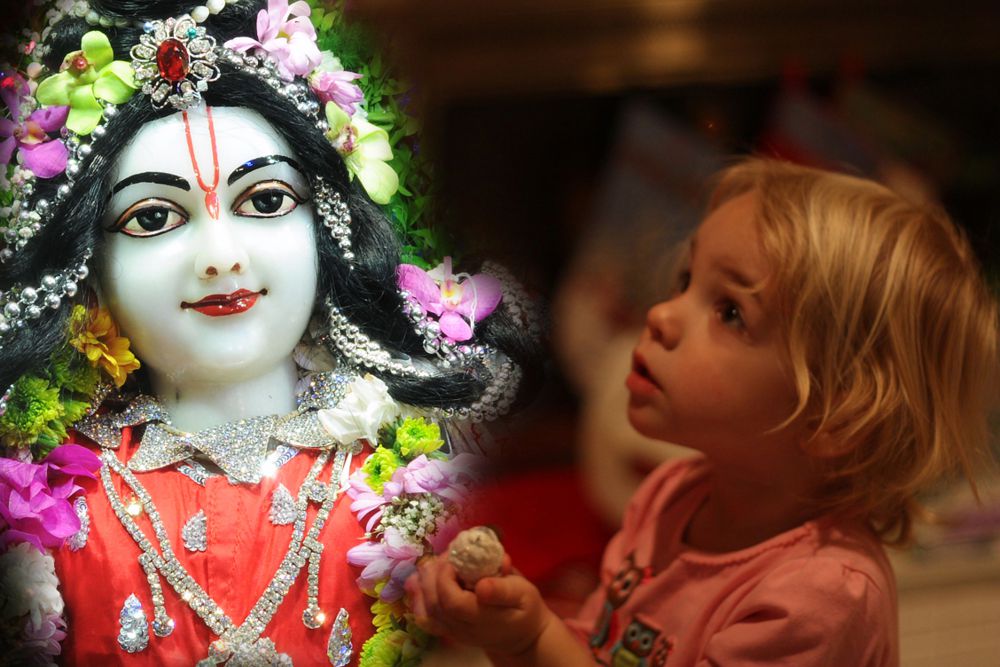
“My dear Vaishnava Thakura, kindly accept me as your dog, as your dog. I am dog already, but I am maya’s dog. I’m not Vaishnava’s dog. So kindly accept me.” If you become a Vaishnava’s dog. Chadiya vaishnava seva, nistar paiche keba. If you do not become a dog of Vaishnava and Nityananda Prabhu.. Nityananda is guru. So if you do not become a dog of Nityananda Prabhu, Vaishnava, or guru, there is no question of happiness. Se sambandha nahi yar, britha janma gelo se pasu boro duracar. Nitai na bolilo mukhe, majila samsara-sukhe. He who has no connection with Nityananda Prabhu, and he does not say, “Jaya Nitai! Jaya Gaura!” (In the wallpaper: from left to right Shri Nityananda Prabhu, ISKCON Chowpatty, Mumbai, a small kid).

